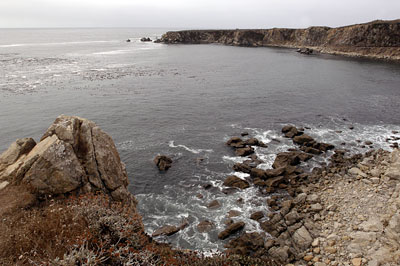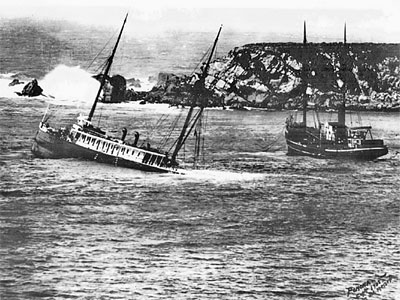National Register of Historic Places in Sonoma County
SS Pomona Shipwreck
Fort Ross Cove
Fort Ross Historic State Park
In the evening dusk, around 6:30pm on March 17, 1908, on route to Eureka, the SS Pomona struck a submerged reef, off the rugged coastline of northern California, while traveling from San Francisco north to Eureka.
Pomona was steaming slowly in heavy seas north towards Eureka, carrying 84 passengers, a crew of 62 men, and 300 tons of general merchandise. Accounts vary, but modern scholars believe Pomona struck Monterey Rock just south of the double-bowl cove below Fort Ross in Sonoma County.
It took several trips for Pomona's lifeboats to ferry all the passengers and the crew to shore. Luckily Pomona did not roll over but remained upright, her bow projecting out of the water perched on the wash rock. Although Pomona was a total loss, there was no loss of life or injury during the abandonment, "even a parrot and three dogs were evacuated."
For twenty years the steamship plied the coastal waters delivering hundreds of passengers and tons of cargo to destinations such as Los Angeles, San Francisco, Point Arena, Mendocino, Eureka, Astoria, Seattle, Victoria and Vancouver. Some of the towns became cities and each and every one of the cities depended on the other towns. Moreover, these cities and towns depended on Pomona, and those Pomona type steamships that followed, to connect the people of the Pacific Coast.
Many ships have been lost along the rugged Pacific coast and never found or the ocean dynamics are so intense that the remains are broadly scattered making identification and interpretation difficult. However, this is not the case with Pomona. The lay of the cove and the annual growth of the kelp forest protected the remains of the shipwreck, so that one hundred years later recreational divers, researchers and fish can still enjoy the shipwreck, garner important historic information from the remains and utilize the habitat.
From the National Register nomination dated 30 January 2008.

Since the National Register of Historic Places was introduced in 1966, the nomination process has become more demanding, particularly in recent years.
The Historic Preservation Act created the National Register of Historic Places on October 15, 1966. National Historic Landmarks and other historic sites already in the National Park System were automtically listed in the new register.
Three National Historic Landmarks locted in Sonoma County became the county's first National Register sites: Fort Ross, Jack London Ranch, and Luther Burbank House and Garden. In 1977, the National Park Service rendered National Register Nomination Forms for these three propertied. The nomination for for Fort Ross contained only five pages, and the nominations for the other two sites contained six pages.
In 1970, two more sites in Sonoma County were designated as National Historic Landmarks and, consequently, listed in the National Register: Fort Ross Commander's House and Petaluma Adobe.
In 1972, the Vallejo Estate became the sixth site in Sonoma County to be added to the National Register, and he first Sonoma County National Register property that is not a National Historic Landmark. This nomination contained only six pages.
The 2008 nomination for the S. S. Pomona Shipwreck contains 133 pages.

